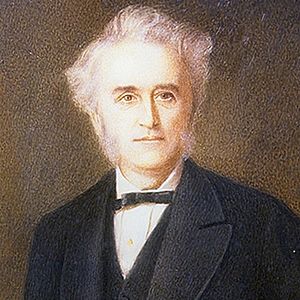John Langdon Down facts for kids
Quick facts for kids
John Langdon Down
|
|
|---|---|
 |
|
| Born |
John Langdon Haydon Down
18 November 1828 |
| Died | 7 October 1896 (aged 67) Teddington, Middlesex, England
|
| Alma mater | London Hospital Medical College |
| Occupation | Medical doctor |
| Known for | First to describe Down syndrome |
| Children | 4 |
John Langdon Down (born November 18, 1828 – died October 7, 1896) was a British doctor. He is famous for being the first to describe a genetic condition now called Down syndrome. He also worked hard to improve the lives of people with intellectual disabilities.
Contents
Early Life and Education
John Langdon Down was born in Torpoint, Cornwall, England. He was the youngest of seven children. His father was a merchant.
When he was 14, John started working with his father, who was a village pharmacist. He read a book called Physics by Arnott, which made him want to study science. At 18, he moved to London. There, he worked for a surgeon, helping with various medical tasks.
Later, he studied at a pharmaceutical lab. He even won a prize for his work in organic chemistry. He also helped the famous scientist Michael Faraday with his experiments on gases.
Becoming a Doctor
In 1853, Down began studying at the Royal London Hospital. He was a very good student and won many awards. In 1856, he became a qualified doctor.
While studying, he lived with his sister. There, he met Mary Crellin, who was his sister's sister-in-law. They got married in 1860.
In 1858, he became the Medical Superintendent at the Earlswood Asylum in Surrey. He worked there for 10 years. This place cared for people with intellectual disabilities.
Improving Care for Patients
John Langdon Down and his wife, Mary, made big changes at Earlswood. Before they arrived, the patients were often treated badly. They faced physical punishment and lived in dirty conditions.
The Downs changed this completely. They stopped all punishment and focused on kindness and rewards. They believed in treating patients with dignity. They taught them many skills like horse riding, gardening, and crafts. John also improved the way the hospital was run. He made sure patients had good food and activities to keep their minds active.
Understanding Different Conditions
In 1866, Down wrote an important paper. It was called "Observations on an Ethnic Classification of Idiots." In this paper, he described different types of intellectual conditions. He suggested that some conditions might look similar to certain ethnic groups.
His paper mainly focused on what we now call Down syndrome. This condition was later named after him. He also used his findings to argue that all humans belong to one species. He believed that if a disease could make people look similar across different groups, then all races must be connected.
Supporting Women's Rights
John Langdon Down also believed in equal opportunities for women. He supported women getting higher education. He disagreed with the idea that education would harm women or their children.
He also thought women should be paid for their work. He asked the leaders of Earlswood to pay his wife, Mary, for her hard work at the hospital. However, they refused because women's contributions were often seen as volunteer work back then. This disagreement led to some tension between Down and the hospital leaders.
In 1868, Down left Earlswood. He resigned after the leaders refused to give him money to show his patients' artwork at an exhibition.
Normansfield: A New Home
After leaving Earlswood, Down opened his own private home. It was for people with developmental and intellectual disabilities. This home was called Normansfield. It was located between Hampton Wick and Teddington.
The first people to live there were 18 children from wealthy families. John and Mary Down worked hard to educate these children. They gave them many activities to stimulate their minds. Normansfield was very successful. It grew over time, and by 1876, it housed 160 people.
Down also made other medical discoveries. He was the first to describe a condition called Prader-Willi syndrome. He called it 'polysarcia'.
In 1887, he wrote a book called "Mental Affections of Childhood and Youth." This book shared his ideas and findings about different mental conditions. It included his thoughts on Down syndrome and microcephaly. He also discussed what he believed might cause these conditions. He often thought about how parents' health could affect their child's health.
John Langdon Down was a respected person in his community. He was elected to the Middlesex County Council. He passed away in 1896 at the age of 67.
Legacy and Impact
John Langdon Down's work had a lasting impact. His two sons, Reginald and Percival, also became doctors. They took over the Normansfield hospital after their father's death. Interestingly, Reginald's son, born in 1905, also had Down syndrome.
Normansfield later became part of the National Health Service in 1952.
A hundred years after his death, Down's contributions were celebrated. A special event was held at the Medical Society of London. The Royal Society of Medicine also published a book about his life.
The main building at Normansfield is now a historic site. It is called the Langdon Down Centre. It is also the headquarters for the Down's Syndrome Association. In his hometown of Torpoint, a street was named Langdon Down Way in his honor.
See also
 In Spanish: John Langdon Down para niños
In Spanish: John Langdon Down para niños

